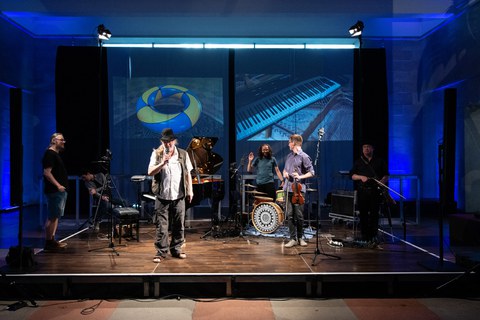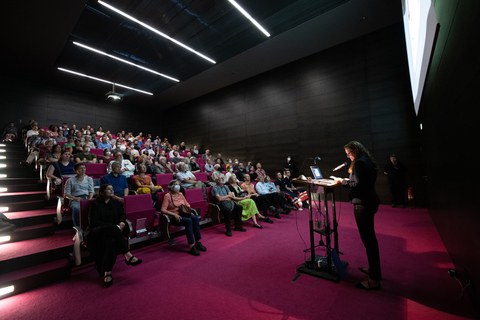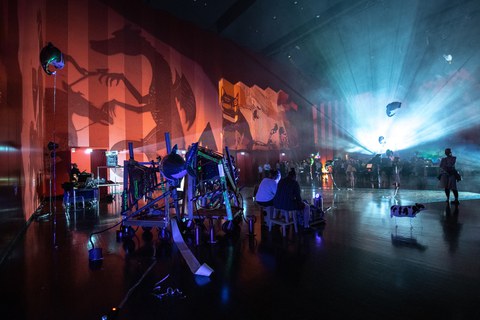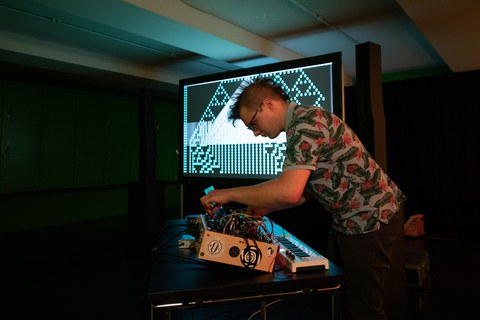Jun 01, 2022
A magical evening of science and art

Mathematics professor Stefan E. Schmidt and his company open the evening with music for the eyes.
Sound & Science presents Visual Music with mathematician Prof. Stefan E. Schmidt and many more.
"MAGIC" is the motto of the Dresden Music Festival 2022, and the audience experienced a truly magical evening on May 23 at this year's edition of "Sound & Science," the joint format of the Dresden Music Festival and the TU Dresden. The eighth edition of the series was dedicated to "Visual Music". In a walking concert at the German Hygiene Museum, musicologists Friederike Wißmann and Gabriele Groll, mathematician Stefan E. Schmidt, artist Franziska Leonhardi and many other contributors presented music for the eyes.
It started in the foyer with a performance by Stefan E. Schmidt & Company. Prof. Schmidt not only holds the professorship for methods of applied algebra at the TU Dresden, but is also a passionate musician himself. He took the audience on a journey through harmonies, where patterns in music became visible even to those who cannot read music. Prof. Schmidt used the 3D animation of a Möbius strip or a torus, on which Euler's Tonnetz was applied. The model, which can be used to represent harmonic relationships between intervals and sounds, is made up of many triangles. These lit up in the animation when Prof. Schmidt played the corresponding chords. At the same time, the visualization illustrated the connection between mathematics and music. After all, music can also be described by numerical ratios - composers such as Beethoven and Bach already made use of this property.

Lecture on the history of visual music by Prof. Friederike Wissmann and Gabriele Groll (University of Music and Theatre Rostock)
At the second stop of the evening in the museum lecture hall, Prof. Friederike Wißmann and Gabriele Groll, both musicologists at the Rostock University of Music and Theatre, spoke about the history of "visual music". It has its origins in abstract painting in the first half of the 20th century. Artists such as Paul Klee and Wassily Kandinsky used musical terms to describe their works. Visual music also found application in the medium of film. In the genre of absolute film of the 1920s and 30s, abstract images were synchronized with music. Today, we encounter visual music primarily in digital form as computer-animated graphics to music. However, abstraction and synesthetic experience remain the central categories of visual music.

The artist Franziska Leonhardi created a mysterious magic world with shadow plays.
Afterwards, the visitors were immersed in a magical musical world. In the darkened great hall of the museum, the artist Franziska Leonhardi created a mysterious atmosphere by means of music, balloons, fog and shadow plays. The performance was accompanied on the piano by Markus Leidenberger, director of music for the regional church.

Florian Helling makes endlessly varying melodies sound with the help of cellular automata.
How mathematics, music and aesthetics fit together was once again demonstrated by the other stations of the Wandelkonzert. At the station "Openguitar Soundscapes" by composer and music psychologist Fernando Bravo, the audience was invited to create images on a screen by playing the guitar themselves. A computer program, to which the guitar was connected, translated frequencies and volume into images, from which a total work of art was created when played. In the mezzanine, endlessly varying melodies were also created by means of Florian Helling's cellular automata. These contain mathematical algorithms with which the artist generated complex geometric and musical patterns.
The participants of "Sound & Science" succeeded with the highest organizational and technical effort to prepare an unforgettable evening for the visitors. They delighted the audience with music for the eyes. The experimental approach impressively demonstrated the connection between science and art, music and mathematics. Thus, the Wandelkonzert hit the core of "Sound & Science" and fully reflected the motto of the music festival.
